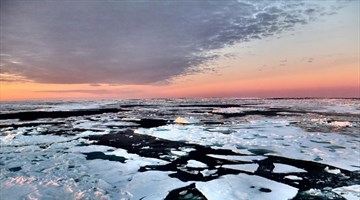TOMSK, Nov 11 –
RIA Tomsk. Employees of Tomsk Polytechnic University (TPU)
during the international Arctic expedition concluded that methane emissions
into the atmosphere in the Arctic increased significantly; in the Laptev Sea
they discovered a field of craters formed in the process of bubbling methane
emissions, the university's press service reported.
Earlier it was
reported that TPU participates in international studies of processes occurring
in the shelf of the polar seas of Eastern Siberia, where more than 90% of the
underwater permafrost and a large amount of hydrocarbons are located.
Scientists have found that methane emissions are coming from under the permafrost,
and they accelerate global warming and can lead to disaster. In 2020, the
international expedition led by Semiletov became the only one in the Arctic.
© предоставлено пресс-службой ТПУ
According to the
press service, the expedition took place from September 27 to November 4 with
the participation of 69 scientists from 10 countries, including specialists
from TPU. On board the Akademik Mstislav Keldysh vessel the researchers covered
about 11000 kilometers, studying the biogeochemical, biological and geodetic
consequences of the degradation of the underground and flood permafrost in the
Russian sector of the Arctic. Upon his return, Semiletov made a report on the
first results of the expedition at the session of the Presidium of the Russian
Academy of Sciences.
Emissions doubled
With reference
to Semiletov, the press service reports that during the expedition, scientists
performed about 300 million measurements of the concentration of dissolved
methane in the surface layer of the Arctic seas using a new highly efficient
technology - with an analytical end on laser spectrometers. Their results once
again confirmed the theory of a high concentration of methane in the seas of
the Eastern Arctic.
"A new discovery
for us was the field of marine craters in the shallow zone of the Laptev Sea.
Craters look like holes in the permafrost. Our studies have shown that marine
craters are formed as a result of massive release of bubbly methane. Their
diameter reaches 30 meters. New craters were also discovered in the East
Siberian Sea", – Semiletov is quoted.
The release
clarifies that methane emissions lead to a rise in water and a change in its
structure. This causes a concentration of methane in the atmosphere: in areas
of powerful emissions, the density reaches 16-32 ppm at a planetary concentration
of 1.25. In the thin surface layer, the methane concentration reaches 35
thousand ppm.
"We have
mapped more than a thousand large seep fields (areas of massive discharge of
bubbly methane with linear dimensions of more than a hundred meters) and
mega-fields (over a thousand meters). Using the micropolygon survey method, we
investigated six mega-seeps in the Laptev and the East Siberian Sea and made a
conclusion about their growth", – Semiletov told.
The scientist
explains that the rate of growth of the cross-section of seep fields, the
number of large jets of methane and its release into the atmosphere are
increasing at different polygons from 5-10 to 100-120%: "One can assert a
doubling of emissions per year".
Background
Earlier it was
reported that TPU scientists under the leadership of Professor Igor Semiletov
are implementing a scientific project "The Siberian Arctic shelf as a
source of greenhouse gases of planetary importance: quantitative assessment of
flows and identification of potential environmental and climatic
consequences". The project is supported by grants from the government of
the Russian Federation and the Russian Science Foundation.
The main theory
of scientists is that due to the melting of the underwater permafrost, large
emissions of the greenhouse gas methane into the Earth's atmosphere occur.
These emissions can have a significant impact on global climate change. To
confirm this hypothesis, scientists have conducted several expeditions to the
Arctic seas of Russia.
The previous
expedition - across the seas of the Eastern Arctic - ended in October 2019. For
35 days polytechnics with colleagues from other Russian scientific and
educational organizations worked on board the research vessel named after
Academician Keldysh. They found a powerful methane release in the East Siberian
Sea with a total area of the gas fountain from four to five square meters.